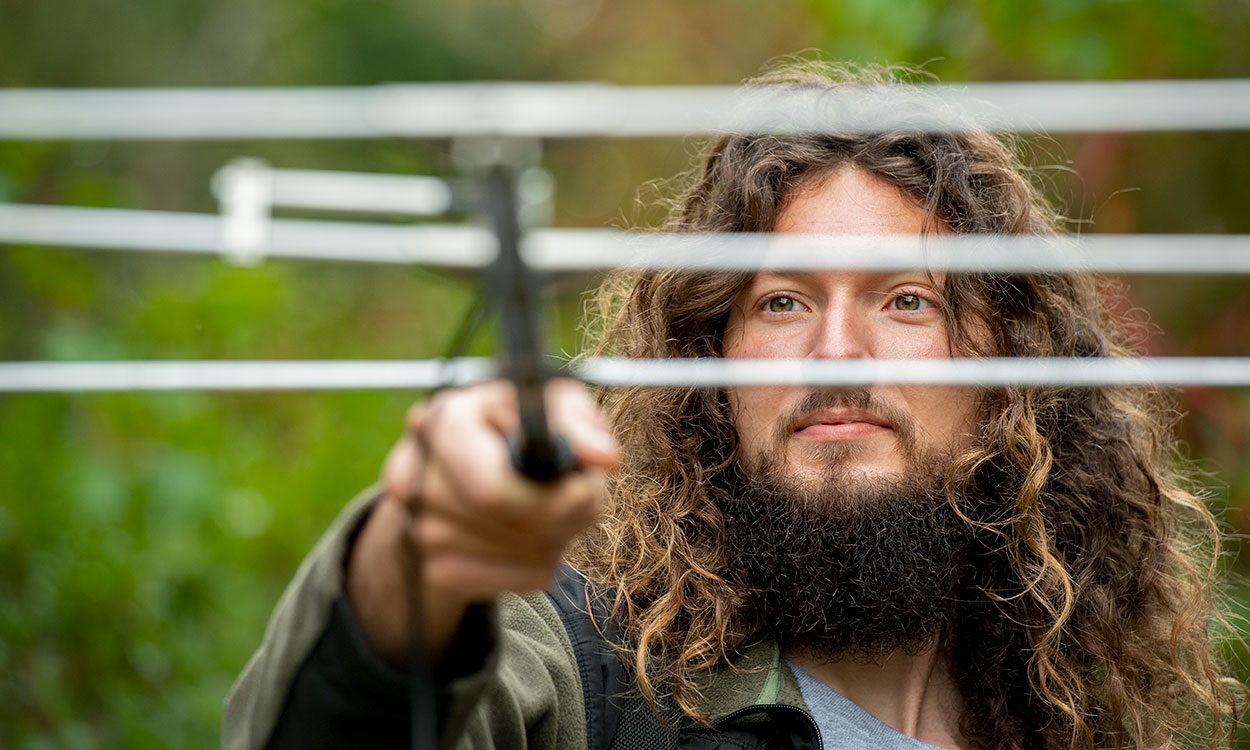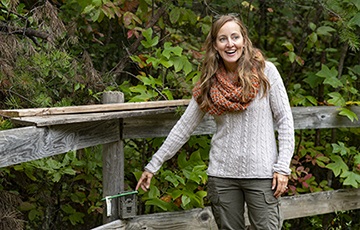Public TV looks at WCU research into predators as habitat changes in mountains

Natural resource conservation and management student Kurtis Fisher gets radio telemetry tracking a nearby coyote.
An ongoing Western Carolina University research project into predators will be featured on a popular public television program next month.
Aimee Rockhill, assistant professor of natural resource conservation and management in WCU’s Geosciences and Natural Resources Department, is conducting studies into how coyotes, a non-native species to the mountain region ― and now found in all 100 counties of the state ― compete with native bobcats and foxes in the same area.
“Sci NC,” a UNC-TV science program hosted by Frank Graff, will highlight the university’s research in an episode scheduled for broadcast Thursday, Oct. 3, at 8:30 p.m. The segment, titled “Bobcats and Foxes: Are They Cool with Coyotes?” examines the complex relationship between the species in a shared habitat.
“We launched our science coverage five years ago, not only to highlight the amazing scientific research that is happening across North Carolina in state and federal labs, our universities and our industries, but also to bring science out of the lab and show how it impacts daily life,” said Graff. A preview of “Sci NC” is available online at science.unctv.org and at UNC-TV’s Facebook page.

Aimee Rockhill
The project is a good example of research with practical applications that “Sci NC” highlights, said Rockhill. Coyotes are a highly adaptable predator, opportunistic in finding food and able to thrive in urban, as well as suburban and rural, areas, according to the North Carolina Wildlife Resources Commission. Sightings are increasingly frequent and most interactions with people are harmless, but preying on livestock and small pets is common.
“Ultimately, I really want to figure out how these three carnivores are allocating space alongside each other on the landscape, how they partition resources and interact with one another so we can better understand how these carnivores behave," Rockhill said. "If we do have exploitative competition, is it through diet, space, time or a combination of these three? Are they using the same space at different times of day, week or month?”
The project also is set up with the learning experiences of participating students in mind as much as wildlife research, she explained.
“It incorporates a number of skills that are required on the job by wildlife technicians,” Rockhill said. “It gets students out in the field and practicing. The teaching-learning-service model is beneficial in that students can take these skill sets into the job market.”
WCU study sites include the Balsam Mountain Preserve residential community and areas adjacent to the Cullowhee campus. Researchers are using various methods to collect data, including radio telemetry with tracking collars, trail cameras and live traps in studying how the animals are interacting, including sharing food resources and territory.
“What attracted me to this project is using the hands-on technical skills,” said Kurtis Fisher, a WCU senior from Mount Holly. “Doing telemetry, trapping, the handling and releasing the animals, those aspects of the work apply to what I’m interested in. I definitely could see a career in a conservation field.”
Knowing the role of predators in various habitats helps people to understand how interconnected species survive, including in local backyards.
“We do have reports of fox sightings during the day. WCU had two reports of a gray fox last year on campus in the middle of the day,” said Rockhill. “Usually what happens is animal control officers have to come, with a notice of a potentially rabid animal, not because of the signs it is exhibiting, but simply because it is out during the day. The movement may be because of a shift in the time of day that animals are active. The local fox population may have movements disrupted by coyotes or may have relocated elsewhere.
“Bobcats are more secretive from human observation, moving more on full moon nights than on new moon nights,” she said. “So, results from this project can tease out any potential resource partitioning between these predators. We’ll also be able to assess interference competition and see if there is any avoidance between the species or intraguild predation, when one predator species kills another predator species, usually to defend its resources,” Rockhill said.
“We would like to expand our research into more urban, denser populated areas. If homeowners in towns would be willing to let us onto their property to capture these species and collect data, it would allow us a broader view and understanding,” she said. “Further, we’re interested in surveying local landowners about their perceptions of these carnivores as well as their abundance and distribution.”
Local landowners interested in participating in this study should contact Rockhill at 828-227-3915 or aprockhill@wcu.edu.

